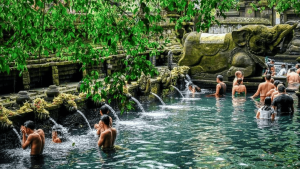Mabiyukukung Ceremony: A Ceremony to ask for fertility of rice in the rice fields in Bali and is closely related to Trihita Karana
The Importance of the Mabiyukukung Ceremony
The mabiyukukung or biyukukung ceremony comes from the words “upacara and biyukukung”. The word “upacara” comes from the root word “upa” which means ‘related to’ and “cara” from the root word “car” which means movement. So the ceremony is interpreted as the movement (implementation) of a series of upakara-upakara in a yadnya to worship Ida Sang Hyang Widhi Wasa and his manifestations.
While the word “biyukukung” comes from the words ‘beya’ and ‘kukung’. The word ‘beya’ means cost and ‘kukung’ comes from the word ‘kung’ which means romance or love. So this mabiyukukung ceremony has the meaning of a request to the manifestation of Ida Sang Hyang Widhi Wasa so that the rice that is pregnant in the rice field or the love meeting between the stigma and pollen and the continuation of fertilization, is successful and safe. This love is intended as Bhatara Sri with Bhatara Wisnu.
When exactly is the Mabiukukung Ceremony held?
Mebanten biukukung is routinely carried out before or when the rice is pregnant or ready to harvest, usually 70 days old. In addition to maintaining tradition, to pray that the rice grows well and is free from pest attacks. This is also done to express gratitude and thanks to Ida Shang Hyang Widhi for the awaited harvest.
Location of the Mabiyukukung Ceremony and people who can perform the Mabiyukukung Ceremony
The mabiukukung ceremony is carried out in the rice fields, or precisely at the cakangan – a water gate or more similarly called a water hole, which is the place (upstream) where water enters each rice field. In the biukukung ceremony, the pemuput does not have to use a pengajian, but the owner or farmer of the rice field can also.
Mabiukukung Ceremony Facilities
In carrying out the mabiyukukung ceremony, there are several offerings used as facilities or media, including the following:
- Tumpeng Banten Sorohan 17
- Banten Tegteg
- Canang Meraka
- Sampiyan Banten Jerimpen di Wakul
- Banten Rantasan Pelinggih Peningan
- Banten Tipat Kelanan and dampulan
- Banten Temuku (Ajuman + Canang Tubungan)
- Sayut Pabersihan
- Canang Gede
- Penjor Biyukukung
The function of the Mabiyukukung Ceremony and is closely related to Trihita Karana
The main function of the Mabiyukukung ceremony is as a means of asking for blessings and fertility for the rice planted so that it can produce abundant fruit. In addition, this ceremony is also a form of expression of gratitude and thanks to Ida Sang Hyang Widhi Wasa for His blessings and gifts so that the rice planted by farmers can grow well.
This ceremony is very important in Bali, and is closely related to the philosophy of Tri Hita Karana, especially the Palemahan aspect – our harmonious relationship with the environment.
This ceremony is specifically performed to ask for fertility for the rice fields. This is a way for farmers to respectfully ask for an abundant harvest. They understand that the success of their harvest depends not only on their hard work, but also on the blessings of nature and the spiritual forces that govern it.
The connection with Tri Hita Karana, and especially Palemahan, is very clear in this practice. This ceremony shows deep respect for the earth and the life-giving forces of nature. By performing Mabiyukukung, Balinese farmers acknowledge their dependence on the environment and strive to maintain a balanced and harmonious relationship with it. It is a reminder that we are all interconnected and that the well-being of the land directly affects our own well-being.
At Puri Gangga Resort also carry out this Mabiukukung activity visit our website at www.purianggaresort.com
Discover More Stories



